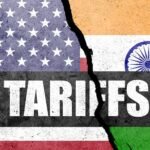Here’s a clear breakdown of the current situation around the Trump administration’s tariffs on Indian imports (as of September 2025):
What’s happening?
1. Tariff Increase: Up to 50%
- In August 2025, President Trump doubled existing U.S. tariffs on Indian goods—from 25% to a hefty 50%. The extra 25% acts as a penalty for India’s continued imports of discounted Russian oil.
- This level of duty places Indian exports on par with countries like Brazil and China under Trump’s punitive policies.
2. Sectors Most Impacted
- Hardest hit industries include textiles, gems & jewelry, shrimp and seafood, leather, footwear, furniture, and apparel. Exemptions: Pharmaceuticals, electronics, and smartphones—key areas spared from the tariffs so far.
Why this decision was made
- The tariff escalation stems from the U.S. view that India’s oil imports from Russia are bolstering the Kremlin’s revenue and undermining U.S. interests, especially around support for Ukraine.
- White House trade adviser Peter Navarro stated that tariffs could be reduced if India stopped buying Russian oil.
How India is reacting
- Delhi condemned the tariffs as unfair and asserted its right to pursue independent energy and economic policies.
- India is pursuing domestic reforms—including potential GST reductions and interest rate cuts—to cushion the economic impact.
- In trade diversification moves, India’s pharmaceutical sector, while currently exempt, is preparing to expand exports into Russia, Brazil, and the Netherlands. Economic and strategic consequences
- GDP growth could slip by up to 1 percentage point due to reduced exports. Export volumes in affected sectors might fall as much as 70%, with overall U.S.-bound shipments declining by 43%.
- Competitors like Vietnam, Bangladesh, Mexico, Turkey, and China may gain market share in India’s place.
- The move is increasingly viewed as a major diplomatic setback, putting strain on long-standing strategic cooperation, including initiatives like the Quad. Economists such as Jeffrey Sachs argue that the tariffs may ultimately backfire on the U.S., erode bargaining leverage, and push India closer to BRICS partners.
What’s next?
- Trade talks have largely stalled. Trump’s administration hints at reopening dialogue if India modifies its energy policy.
- India continues to signal resilience—diversifying trade, enhancing reforms, and reinforcing strategic autonomy.
Summary Table
| Aspect | Details |
| Tariff Rate | Increased to 50% from 25% due to Russian oil imports |
| Key Affected Sectors | Textiles, gems, seafood, leather, footwear, furniture |
| Exempt Sectors | Pharmaceuticals, electronics, smartphones |
| Economic Impact | Up to 1% GDP growth hit, export volume collapse up to 70% |
| Strategic Fallout | Diplomatic strain, potential realignment toward Russia/China |
| India’s Response | Domestic reforms, market diversification, asserting strategic autonomy |
| U.S. Position | Pressure tactics tied to energy policy; possibility of de-escalation if India stops Russian imports |








